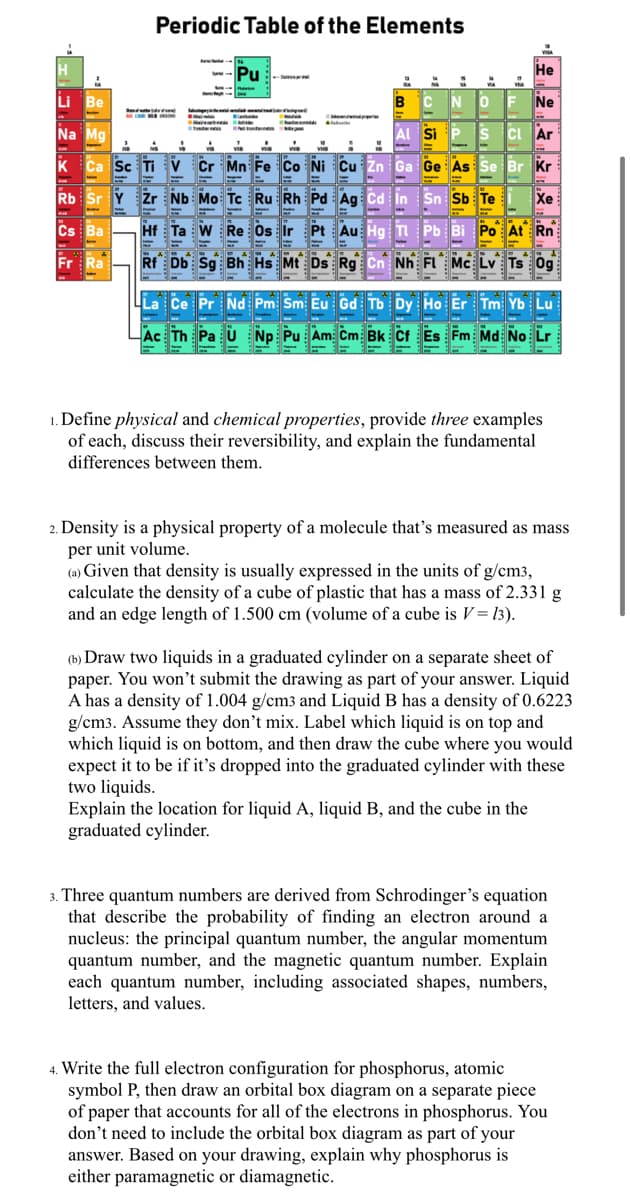Density is a physical property of a molecule that's measured as mass per unit volume. (a) Given that density is usually expressed in the units of g/cm3, calculate the density of a cube of plastic that has a mass of 2.331 g and an edge length of 1.500 cm (volume of a cube is V= 13). (b) Draw two liquids in a graduated cylinder on a separate sheet of paper. You won't submit the drawing as part of your answer. Liquid A has a density of 1.004 g/cm3 and Liquid B has a density of 0.6223 g/cm3. Assume they don't mix. Label which liquid is on top and which liquid is on bottom, and then draw the cube where you would expect it to be if it's dropped into the graduated cylinder with these two liquids. Explain the location for liquid A, liquid B, and the cube in the graduated cylinder.
Density is a physical property of a molecule that's measured as mass per unit volume. (a) Given that density is usually expressed in the units of g/cm3, calculate the density of a cube of plastic that has a mass of 2.331 g and an edge length of 1.500 cm (volume of a cube is V= 13). (b) Draw two liquids in a graduated cylinder on a separate sheet of paper. You won't submit the drawing as part of your answer. Liquid A has a density of 1.004 g/cm3 and Liquid B has a density of 0.6223 g/cm3. Assume they don't mix. Label which liquid is on top and which liquid is on bottom, and then draw the cube where you would expect it to be if it's dropped into the graduated cylinder with these two liquids. Explain the location for liquid A, liquid B, and the cube in the graduated cylinder.
Chemistry: An Atoms First Approach
2nd Edition
ISBN:9781305079243
Author:Steven S. Zumdahl, Susan A. Zumdahl
Publisher:Steven S. Zumdahl, Susan A. Zumdahl
Chapter1: Chemical Foundations
Section: Chapter Questions
Problem 3ALQ: Which of the following is true about an individual atom? Explain. a. An individual atom should be...
Related questions
Question
What’s the answer to 2.

Transcribed Image Text:Periodic Table of the Elements
Pu
Не
Li Be
CNOF
Ne
Na Mg
Al Si
s CI Ar
Sc Ti V Čr Mn Fe Co Ni Cu Zn Ga Ge As
Se
Br Kr
Rb Sr Y Žr Nb Mo: Tc Ru Rh Pd Ag Cd In Sn Sb Te
Xe
Cs Ba
Hf Ta W Re Os Ir Pt Au Hg TI Pb
Po At Rn
Rf Db Sg Bh Hs Mt Ds Rg Cn Nh FL Mc Lv Ts Og
La Ce Pr Nd Pm Sm Eu Gd Tb Dy Ho Er Tm Yb Lu
Ac Th Pa U Np Pu Am: Cm Bk Cf Es Fm Md No Lr
1. Define physical and chemical properties, provide three examples
of each, discuss their reversibility, and explain the fundamental
differences between them.
2. Density is a physical property of a molecule that's measured as mass
per unit volume.
(a) Given that density is usually expressed in the units of g/cm3,
calculate the density of a cube of plastic that has a mass of 2.331 g
and an edge length of 1.500 cm (volume of a cube is V= 13).
(b) Draw two liquids in a graduated cylinder on a separate sheet of
paper. You won't submit the drawing as part of your answer. Liquid
A has a density of 1.004 g/cm3 and Liquid B has a density of 0.6223
g/cm3. Assume they don't mix. Label which liquid is on top and
which liquid is on bottom, and then draw the cube where you would
expect it to be if it's dropped into the graduated cylinder with these
two liquids.
Explain the location for liquid A, liquid B, and the cube in the
graduated cylinder.
3. Three quantum numbers are derived from Schrodinger's equation
that describe the probability of finding an electron around a
nucleus: the principal quantum number, the angular momentum
quantum number, and the magnetic quantum number. Explain
each quantum number, including associated shapes, numbers,
letters, and values.
4. Write the full electron configuration for phosphorus, atomic
symbol P, then draw an orbital box diagram on a separate piece
of paper that accounts for all of the electrons in phosphorus. You
don't need to include the orbital box diagram as part of your
answer. Based on your drawing, explain why phosphorus is
either paramagnetic or diamagnetic.
Expert Solution
This question has been solved!
Explore an expertly crafted, step-by-step solution for a thorough understanding of key concepts.
This is a popular solution!
Trending now
This is a popular solution!
Step by step
Solved in 4 steps

Recommended textbooks for you

Chemistry: An Atoms First Approach
Chemistry
ISBN:
9781305079243
Author:
Steven S. Zumdahl, Susan A. Zumdahl
Publisher:
Cengage Learning

Chemistry: Matter and Change
Chemistry
ISBN:
9780078746376
Author:
Dinah Zike, Laurel Dingrando, Nicholas Hainen, Cheryl Wistrom
Publisher:
Glencoe/McGraw-Hill School Pub Co

General Chemistry - Standalone book (MindTap Cour…
Chemistry
ISBN:
9781305580343
Author:
Steven D. Gammon, Ebbing, Darrell Ebbing, Steven D., Darrell; Gammon, Darrell Ebbing; Steven D. Gammon, Darrell D.; Gammon, Ebbing; Steven D. Gammon; Darrell
Publisher:
Cengage Learning

Chemistry: An Atoms First Approach
Chemistry
ISBN:
9781305079243
Author:
Steven S. Zumdahl, Susan A. Zumdahl
Publisher:
Cengage Learning

Chemistry: Matter and Change
Chemistry
ISBN:
9780078746376
Author:
Dinah Zike, Laurel Dingrando, Nicholas Hainen, Cheryl Wistrom
Publisher:
Glencoe/McGraw-Hill School Pub Co

General Chemistry - Standalone book (MindTap Cour…
Chemistry
ISBN:
9781305580343
Author:
Steven D. Gammon, Ebbing, Darrell Ebbing, Steven D., Darrell; Gammon, Darrell Ebbing; Steven D. Gammon, Darrell D.; Gammon, Ebbing; Steven D. Gammon; Darrell
Publisher:
Cengage Learning

Introductory Chemistry: A Foundation
Chemistry
ISBN:
9781337399425
Author:
Steven S. Zumdahl, Donald J. DeCoste
Publisher:
Cengage Learning

World of Chemistry, 3rd edition
Chemistry
ISBN:
9781133109655
Author:
Steven S. Zumdahl, Susan L. Zumdahl, Donald J. DeCoste
Publisher:
Brooks / Cole / Cengage Learning